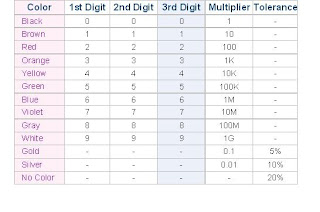As shown in Figure 1, a common resistor usually has 4 color bands, the first two of which indicates the first and second digit of its resistance value while the third band indicates the number of zeros that follows the first two digits. The fourth band indicates the error or tolerance of the resistor. For example, the top resistor in Figure has a resistance value of 1 kilo-ohm (10 ohms x 100) +/- 5%. Some resistors have 5 color bands to indicate their resistance values more precisely, an example of which is the bottom resistor of Figure.
Monday, 9 January 2012
Finding resistance of a resistor.
As shown in Figure 1, a common resistor usually has 4 color bands, the first two of which indicates the first and second digit of its resistance value while the third band indicates the number of zeros that follows the first two digits. The fourth band indicates the error or tolerance of the resistor. For example, the top resistor in Figure has a resistance value of 1 kilo-ohm (10 ohms x 100) +/- 5%. Some resistors have 5 color bands to indicate their resistance values more precisely, an example of which is the bottom resistor of Figure.
Subscribe to:
Post Comments (Atom)


1 comment:
To remember the order of colours we are having a short cut as :
"BBROY Great Britan Very Good Wife".
where,
B- Black
B- Brown
R- Red
O- Orange
Y- Yellow
Great- Green
Britan- Blue
Very- Violet
Good- Gray
Wife- White
Post a Comment